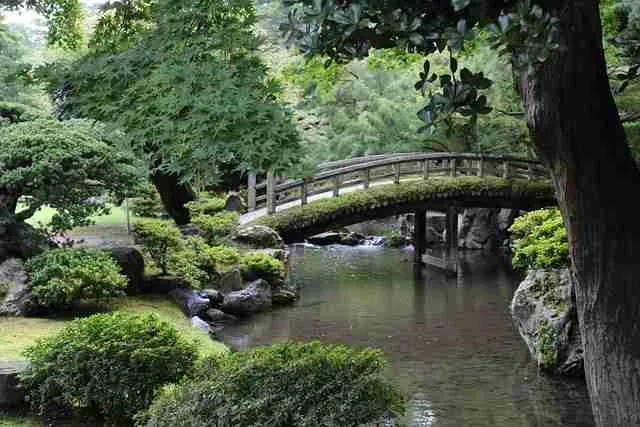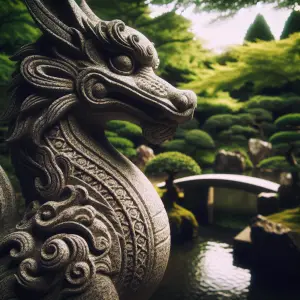Do you ever find yourself yearning for a place of tranquility and serenity amidst the hustle and bustle of daily life? Look no further than Japanese Zen gardens, where meticulously designed pathways guide you on a soothing journey of self-reflection and inner peace.
In these enchanting landscapes, pathways play a pivotal role, leading you through carefully arranged elements of nature and design. From the meandering stepping stones symbolizing the path of life to the raked gravel representing the ebb and flow of water, each pathway serves as a gateway to contemplation and connection with nature.
So, step into the world of Japanese Zen gardens and discover the captivating pathways that beckon you to embark on a profound spiritual journey.
The Significance of Pathways in Japanese Zen Gardens
Japanese Zen gardens have long been revered for their peaceful and tranquil ambiance. These carefully designed spaces evoke a sense of serenity and provide an opportunity for contemplation and self-reflection. One of the key elements that contribute to the overall aesthetic and spiritual experience of these gardens is the pathways that wind their way through the landscape.
Symbolism of Zen Garden Pathways
In Japanese Zen philosophy, pathways hold deep symbolic meaning. They are seen as the journey of life, representing the various paths and choices that one encounters on their personal and spiritual journey. The act of walking along these pathways is believed to be a form of meditation, where one can find clarity and inner peace.
Impact on the overall design of the garden
Pathways play a crucial role in the overall design of Japanese Zen gardens. They function as visual and physical connectors, leading the observer through the garden and inviting them to explore and engage with the space. The layout and composition of the pathways influence the flow and balance of the garden, creating a harmonious and cohesive experience for the visitor.
Use of pathways for guided meditation
In addition to their aesthetic and functional roles, pathways in Japanese Zen gardens are often used for guided meditation. These gardens are designed as spaces for individuals to experience deep introspection and contemplation. The pathways guide the visitor through the garden, encouraging them to focus on the present moment and engage in a mindful meditation practice.
Design Elements of Zen Garden Pathways
The design elements of Zen garden pathways are deeply rooted in both Taoist and Buddhist philosophies. These philosophies emphasize harmony with nature and the acceptance of impermanence.
Influences from Taoist and Buddhist philosophies
Taoist philosophy encourages individuals to align themselves with the natural flow and rhythm of the universe. This concept is reflected in the design of Zen garden pathways, which often mimic the meandering paths found in nature, such as rivers or streams. The pathways are intentionally designed to blend seamlessly with the surrounding landscape, creating an organic and harmonious experience.
Buddhist philosophy, on the other hand, teaches the acceptance of impermanence and the transient nature of all things. The design of Zen garden pathways often incorporates elements that are subject to change, such as moss or gravel, reflecting this principle and reminding visitors of the impermanence of life.
Integration with natural elements
Zen garden pathways are carefully integrated with various natural elements, such as rocks, plants, and water features. These elements are strategically placed along the pathways, creating a sense of balance and harmony between the man-made and natural components of the garden. This integration further enhances the meditative and reflective qualities of the pathways, promoting a deeper connection with nature and the self.

Variety of Zen Garden Pathways
There are several types of pathways commonly seen in Japanese Zen gardens. Each type has its own unique characteristics and symbolic significance.
Types of pathways commonly seen
- Nobedan Pathways: These pathways are characterized by their use of rectangular or square stepping stones, placed in a symmetrical pattern.
- To-jiro Pathways: To-jiro paths feature irregularly shaped stepping stones, often arranged in a more organic and naturalistic manner.
- Chirikawa Pathways: Chirikawa paths consist of narrow stone walkways bordered by a shallow trench filled with sand or gravel.
- Stepping Stone Pathways: Stepping stone paths are typically made up of large flat stones placed at regular intervals, creating a stepping stone-like effect.
Influence on the choice of type
The choice of pathway type in a Zen garden depends on various factors, including the desired aesthetic, the intended purpose of the garden, and the overall design principles followed by the designer. Each type of pathway offers a unique experience and carries its own symbolism, contributing to the overall ambiance and meaning of the garden.
Individual characteristics of different pathways
Nobedan pathways, with their geometric patterns, evoke a sense of order and structure. They often symbolize the journey to enlightenment, with each step representing a milestone or a stage of spiritual development.
To-jiro pathways, on the other hand, embrace the organic and irregular nature of the natural world. The uneven and irregularly placed stepping stones encourage a more mindful and present-moment awareness, as one carefully navigates the path.
Chirikawa pathways, with their narrow and focused design, create a sense of direction and purpose. Walking along these paths can be seen as a metaphorical journey towards inner peace and self-discovery.
Stepping stone pathways offer a balanced blend of structure and natural beauty. The regular intervals between the stones provide a rhythmic and harmonious walking experience, encouraging a sense of flow and ease.
Nobedan Pathways
Nobedan pathways are one of the most commonly seen types of pathways in Japanese Zen gardens. They are characterized by rectangular or square stepping stones, meticulously arranged in symmetrical patterns.
Construction and materials used
Nobedan pathways are typically constructed using large stones, such as granite or limestone. These stones are carefully selected for their size, shape, and color, and then arranged to create a cohesive and visually appealing design. The stones are often set in a base material, such as sand or gravel, to ensure stability and durability.
Symbolism represented by Nobedan
Nobedan pathways hold significant symbolism in Japanese Zen philosophy. The rectangular or square shape of the stepping stones represents stability and order. The symmetrical arrangement reflects the balance and harmony sought in Zen practice. Walking along these pathways is believed to promote mindfulness and self-reflection, as each step is deliberate and purposeful.
Examples of well-known Zen Gardens with Nobedan paths
Some well-known Zen gardens that feature Nobedan pathways include Ryoan-ji in Kyoto and Daisen-in in Daitoku-ji temple complex. These gardens showcase the intricate beauty and symbolism of the Nobedan paths, inviting visitors to embark on a journey of self-discovery and contemplation.
To-jiro Pathways
To-jiro pathways offer a unique and naturalistic approach to Zen garden design. These paths are characterized by irregularly shaped stepping stones, carefully placed to create a sense of natural flow and movement.
Distinguishing features of To-jiro paths
The irregularly shaped stepping stones used in To-jiro pathways are often sourced from natural materials, such as river rocks or boulders. These stones are chosen for their unique shapes and textures, and are placed in a manner that mimics the randomness of nature. The result is a pathway that blends seamlessly with the surrounding landscape, creating a sense of unity and interconnectedness.
Symbolism and influence on Zen Meditation
To-jiro pathways embody the Zen philosophy of embracing imperfection and accepting the unpredictability of life. The irregular shapes and placement of the stepping stones serve as a reminder of the ever-changing nature of existence. Walking along these paths encourages a mindful and present-moment awareness, as one navigates the uneven terrain, learning to embrace the impermanence and unpredictability of life.
Famous Zen Gardens with To-jiro paths
The famous Zen garden at Ryoan-ji temple in Kyoto is known for its To-jiro pathway design. The irregularly shaped stepping stones in this garden echo the natural beauty of the surrounding environment, creating a serene and contemplative atmosphere. The garden at Tofuku-ji temple in Kyoto is another notable example, with its To-jiro paths leading visitors through a lush and tranquil landscape.
Chirikawa Pathways
Chirikawa pathways, also known as Roji paths, are narrow stone walkways bordered by a shallow trench filled with sand or gravel. These paths are commonly found in Japanese tea gardens and are an integral part of the tea ceremony experience.
Design elements of Chirikawa paths
Chirikawa paths are designed with simplicity and focus in mind. The narrow width of the path encourages a slow and deliberate walking pace, allowing the practitioner to immerse themselves in the present moment. The sand or gravel-filled trench that borders the path adds a visual element of texture and contrast, creating a sense of serenity and tranquility.
Impact and significance of Chirikawa paths in Zen practice
Chirikawa paths play a significant role in Zen practice, particularly in the context of the tea ceremony. Walking along these paths before entering the tea house is seen as a transitional experience, preparing the mind and body for the meditative and mindful practice of tea. The narrow and focused design of Chirikawa paths encourages a sense of inner reflection and concentration, setting the stage for a deeply centered and mindful tea ceremony.
Notable Zen Gardens featuring Chirikawa paths
The gardens at Kennin-ji temple in Kyoto and Kodai-ji temple in Kyoto both feature Chirikawa paths that lead visitors to the tea houses. These paths provide a serene and contemplative journey, inviting guests to immerse themselves in the beauty and peacefulness of the surroundings.
Stepping Stone Pathways
Stepping stone pathways are a classic and timeless feature found in many Japanese Zen gardens. These paths consist of large flat stones placed at regular intervals, creating a stepping stone-like effect.
Stepping stone paths construction and materials
Stepping stone paths are typically constructed using flat stones, such as slate or granite, that are large enough to comfortably walk on. The stones are placed at regular intervals, creating a rhythm and flow to the path. The gaps between the stones are often filled with a layer of sand or gravel to provide stability and aesthetics.
The role of stepping stone paths in Zen thought
Stepping stone paths embody the Zen philosophy of embracing simplicity and finding beauty in the ordinary. These paths encourage a mindful and present-moment awareness, as one carefully navigates from one stone to the next. Each step becomes an opportunity for introspection and self-reflection, as the practitioner immerses themselves in the meditative journey.
Examples of Zen Gardens with stepping stone paths
The iconic garden at Ginkaku-ji, also known as the Silver Pavilion, in Kyoto showcases the beauty and elegance of stepping stone paths. The carefully arranged stones guide visitors through the garden, offering moments of reflection and contemplation. The Zen garden at Daisen-in temple in Kyoto also features stepping stone paths, inviting guests to embark on a mindful journey through the tranquil landscape.
Creation and Maintenance of Pathways in Zen Gardens
The creation and maintenance of pathways in Zen gardens follow traditional methods and practices that have been passed down for generations. These methods focus on preserving the integrity and symbolism of the pathways while maintaining their functionality and aesthetic appeal.
Traditional methods of pathway creation
The creation of pathways in Zen gardens involves careful planning and attention to detail. The path is first marked out using rope or string, allowing the designer to visualize the layout and flow. The stones are then selected based on their size, shape, and color to ensure a harmonious and balanced design. Each stone is placed with precision, ensuring stability and an even surface for walking.
Materials used and their significance
The materials used in pathways, such as stones, sand, and gravel, hold symbolic significance in Zen philosophy. Stones represent stability and grounding, while sand and gravel symbolize the transient and ever-changing nature of existence. These materials are chosen for their natural beauty and ability to create a harmonious and contemplative atmosphere in the garden.
Maintenance practices and their role in Zen discipline
Maintaining the pathways in Zen gardens is considered an essential part of Zen discipline. It requires regular upkeep, such as sweeping away fallen leaves or refreshing the sand or gravel in Chirikawa paths. These maintenance practices serve as a mindful and meditative activity, encouraging practitioners to cultivate discipline and attention to detail. The act of caring for the pathways is seen as a reflection of one’s commitment to the Zen practice and a way to connect with the garden’s inherent spirituality.
The Role of Pathways in the Zen Meditation Process
Pathways in Zen gardens serve as guides and companions on the meditation journey. They play a crucial role in creating a serene and contemplative atmosphere, allowing practitioners to delve deep into their meditation practice.
Pathways as guides through the garden
Pathways in Zen gardens lead visitors on a carefully curated journey, guiding them through various elements of the garden and inviting them to explore and engage with their surroundings. The paths create a sense of direction and purpose, providing a clear focus for the meditative journey.
Impact on the meditative journey
Walking along the pathways in a Zen garden can have a profound impact on the meditative journey. The deliberate and mindful act of walking encourages a heightened state of present-moment awareness, allowing practitioners to let go of distractions and fully immerse themselves in the experience. The repetitive motion of each step becomes a form of meditation in itself, helping to calm the mind and cultivate a sense of inner stillness.

Effect on the overall Zen experience
The pathways in a Zen garden significantly contribute to the overall Zen experience. They offer a tangible and visual representation of the spiritual journey, reminding practitioners of the interconnectedness of life and the impermanence of all things. The mindful walking practice along the pathways enhances the meditation process, allowing individuals to deepen their understanding of themselves and the world around them.
Comparative Study of Pathways in Traditional Zen Gardens
A comparative study of pathways in traditional Zen gardens reveals the diverse approaches and interpretations of this fundamental design element. Various factors, such as region, sect, and historical context, influence the selection and design of pathways, resulting in distinct styles and characteristics.
Contrasting different types of paths and their use
Nobedan, To-jiro, Chirikawa, and stepping stone paths each offer a unique experience and purpose in the context of Zen gardens. Nobedan paths emphasize order and structure, To-jiro paths embrace natural beauty and imperfection, Chirikawa paths provide a focused and contemplative journey, and stepping stone paths encourage simplicity and mindfulness. Contrasting these different types of paths reveals the breadth of creative expression within Zen garden design.
Influence of region and sect on pathway selection
Pathway selection in Zen gardens can vary based on the region and sect in which the garden is located. Certain regions may have specific aesthetic preferences or cultural influences that inform the design choices. Additionally, different Zen sects may have distinct interpretations of Zen philosophy, which can be reflected in the selection and design of pathways. Exploring these regional and sectarian influences provides insights into the diverse manifestations of Zen garden design.
Contemporary interpretations of classic Zen pathways
In contemporary Zen garden design, there is a continued exploration and reinterpretation of classic Zen pathways. Contemporary designers may incorporate new materials, shapes, or techniques while still honoring the fundamental principles and symbolism of Zen gardens. These modern interpretations offer a fresh perspective on traditional Zen pathways, allowing for the evolution and adaptation of this timeless design element.
In conclusion, the significance of pathways in Japanese Zen gardens cannot be overstated. They serve as symbolic representations of life’s journey, contribute to the overall design and flow of the garden, and provide a means for guided meditation. Each type of pathway, from Nobedan to To-jiro, Chirikawa, and stepping stone paths, offers a unique experience and carries its own symbolism. The construction and maintenance of pathways follow traditional methods and materials that align with Zen philosophy. Pathways play a crucial role in the Zen meditation process, guiding practitioners on a transformative journey of self-discovery. A comparative study of pathways in traditional Zen gardens highlights the diversity and creativity within this foundational design element. Whether in traditional or contemporary interpretations, pathways in Japanese Zen gardens continue to inspire and facilitate moments of reflection, tranquility, and spiritual connection.




